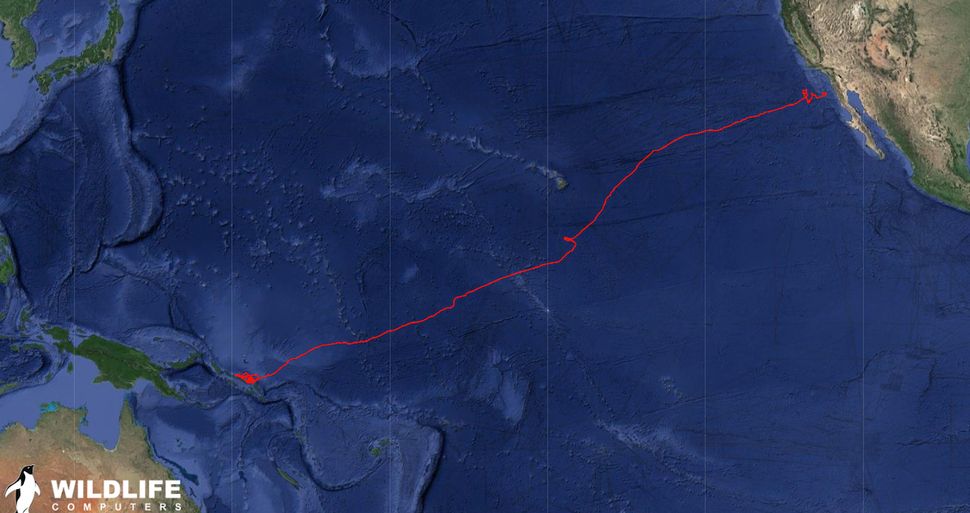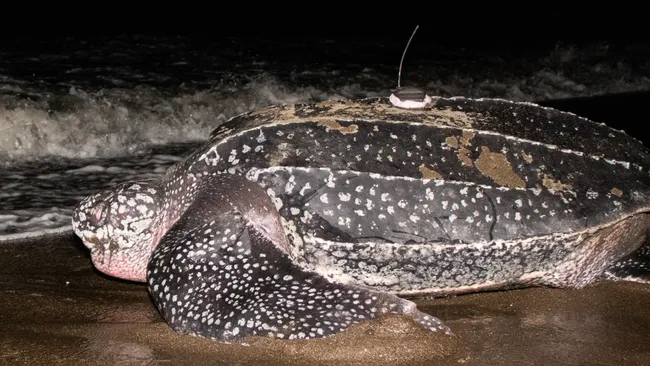A leatherback turtle from the Western Pacific, which nested in the Solomon Islands, astonished conservationists by diving to an extraordinary depth of 4,409 feet. Earlier this year, this leatherback (Dermochelys coriacea) embarked on its journey from a nesting site in the Solomon Islands and descended 4,409 feet (1,344 meters) into the ocean, as reported by The Nature Conservancy.
This dive surpassed the existing Guinness World Record for the deepest turtle dive, previously set at 4,199 feet (1,280 meters) by another leatherback. For comparison, Navy submarines typically reach depths of about 2,950 feet (900 meters), and the deepest human scuba dive is recorded at 1,090 feet (332 meters).
The dive was recorded as part of a satellite tracking study aimed at protecting leatherbacks. Another turtle from this study swam across the entire Pacific Ocean. Peter Waldie, a marine scientist leading The Nature Conservancy’s Solomon Islands Program, described the deep dive and extensive migration as “truly spectacular.”
“Leatherbacks are incredible creatures,” Waldie told Live Science. “The ability to swim nonstop across the Pacific and dive as deep as a Navy submarine on a single breath is mind-blowing.”

Live Science has approached Guinness World Records regarding this new claim. A spokesperson indicated that such data-driven records are typically verified after the findings are published in a peer-reviewed journal.
Leatherbacks possess several adaptations for deep diving. Despite being air breathers, they can hold their breath for up to 90 minutes. Their carapace (upper shell) expands and contracts to withstand deep-sea pressures.
Scientists theorize that leatherbacks dive deep primarily to hunt jellyfish, which migrate vertically in the water column. Waldie explained that leatherbacks spend most of their lives at sea, with females coming ashore briefly to lay eggs. The Solomon Islands’ nesting leatherbacks are part of the critically endangered Western Pacific population, estimated to include about 1,400 breeding adults.
“We cannot afford to lose any of these creatures,” Waldie emphasized. “Every breeding adult and every nest saved is crucial for the next generation.”
Since 2022, Waldie and his team have tagged 17 leatherbacks nesting in Isabel Province, where local community rangers protect turtles and their eggs from threats. The record-setting leatherback, named “Uke Sasakolo” after the Sasakolo nesting beach, set the depth record on March 25, shortly after leaving the nesting grounds.
Uke Sasakolo nested during the peak season from November to January. The tagged leatherbacks usually migrate to southern Australian and New Zealand waters, but one named “Aunty June” took an unusual route, heading straight across the Pacific to feeding grounds off Baja California, Mexico. Waldie hopes to confirm whether mid-year nesters like Aunty June commonly follow this eastern route, while peak season nesters head south.
“We call them all Western Pacific nesters, but we might discover that these subpopulations head to entirely different foraging areas,” he noted.
